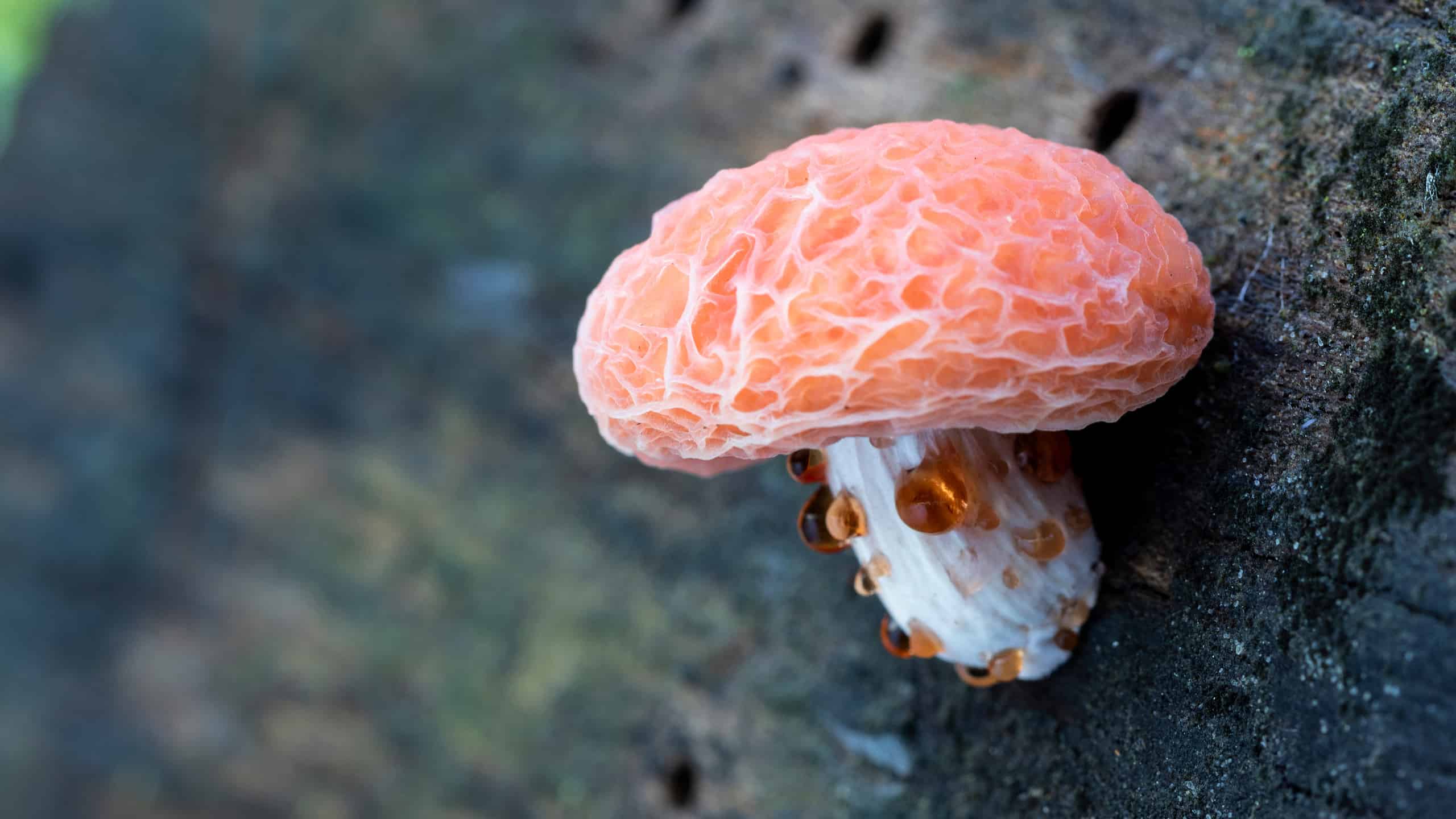First of all, pink is a rather rare color when it comes to fungi, but these dazzling fungal gems can be found across the globe. Moreover, a few are even fit for eating. Therefore, if pink intrigues you, look no further. Read right here to learn more about 10 types of pink mushrooms.
1. Pleurotus djamour
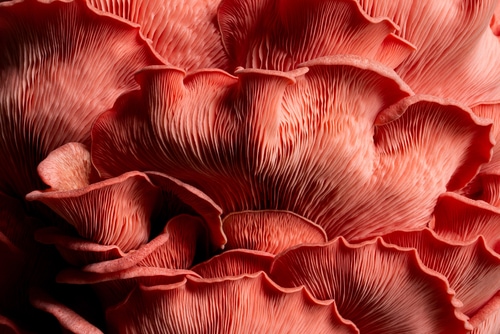
Close-up of the “Pink Oyster” mushroom.
©peck of pickles/Shutterstock.com
First comes Pleurotus djamour, appropriately named the “Pink Oyster” mushroom, which has a delicate slightly sweet, and mildly nutty flavor. Native to Southeast Asia, this is popular in central Mexican communities where locals call it a variety of names including, “seta”, “cazahuate”, “orejon”, and “hongo de pino”. Unfortunately, this only grows wild in tropical climates. It is rare in supermarkets as its shelf life is only about one day.
2. Rhodotus palmatus
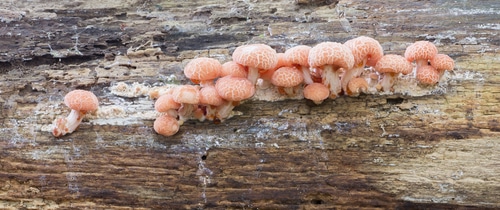
A cluster of pink “Wrinkled Peach” mushrooms.
©Gertjan Hooijer/Shutterstock.com
A second is a jaw-dropping pink mushroom named Rhodotus palmatus, or the Wrinkled Peach mushroom. To begin with, this unmistakable mushroom has a stunning pattern atop the cap which resembles veins. Secondly, it has pink gills under the cap and a pale pinkish spore print. As a final point, it is incredibly rare, yet this species still can be found in over 30 countries. It is so rare that it is protected by law in several European countries including Poland, Slovakia, Estonia, and Serbia. Not only that, but it is on the Red List of currently 11 countries, listed mostly as endangered or critically endangered. Consequently, this is due to the decline of its primary host trees which are elm and ash.
3. Mycena rosa

The “Rosy Bonnet” is one pink mushroom that you should not eat.
©W. de Vries/Shutterstock.com
Next in our list of pink mushrooms comes Mycena rosa, or the “Rosy Bonnet”. This marvel is not edible as it contains the toxin muscarine. Thus, eating this causes extreme vomiting, diarrhea, as well as excessive salivating and sweating. It is, however, one of the bioluminescent mushrooms, which means this baby glows in the dark!
4. Porpolomopsis calyptriformis
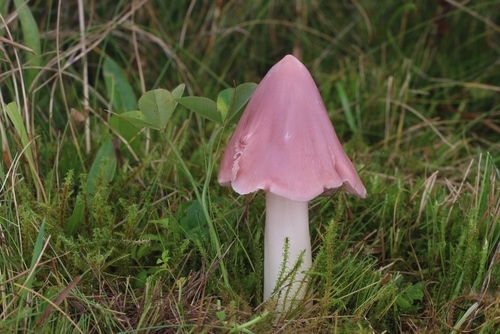
The “Pink Waxcap” mushroom growing in a field.
©bob.leccinum.Robert Kozak/Shutterstock.com
Moving right along, Porpolomopsis calyptriformis is found throughout Europe and is known as the “Pink Waxcap” mushroom. Most commonly found in the United Kingdom, it is rare. Unimproved fields and pastures are its preferred habitat. This pink mushroom unfortunately also is on the Red List of several European countries due to its rarity.
5. Hygrophorus russula
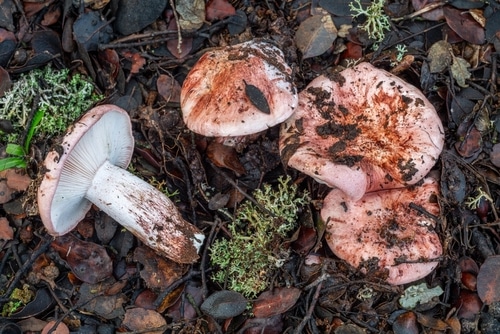
This pink waxcap mushroom more resembles the genus
Russula.
©LFRabanedo/Shutterstock.com
Succeeding is Hygrophorus russula which looks like a species of the genus Russula, but deceptively is not. Hence, the “False Russula” is its common name. With its wax-textured cap, this edible pink mushroom varies in opinion on quality.
6. Entoloma quadratum

The “Unicorn Mushroom”.
©MargareeClareys/Shutterstock.com
Entoloma quaratum, a.k.a. the “Unicorn Mushroom”, is closer in color to salmon, yet still holds its ground amongst pink mushrooms. The entire mushroom: cap, gills, stem, and even spores are pink. How’s that for a pink mushroom? Too small to be of edible significance anyway, this species is toxic.
7. Ramaria botytis
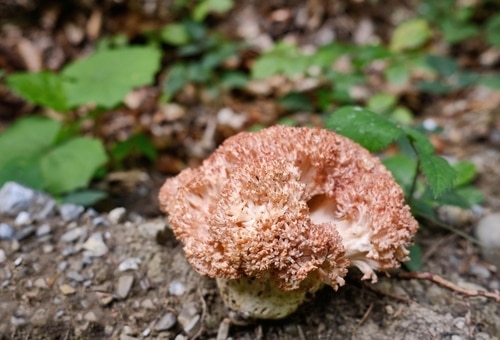
The “Pink Tipped Coral” mushroom is even edible.
©katyapulka/Shutterstock.com
Ensuing is in the pink coral-shaped mushroom Ramaria botrytis. Appropriately called the “Pink Tipped Coral”, it is one of the best coral mushrooms to eat. This has a rounded or chunky base with crowded pink tips and resembles cauliflower. Additionally, it has a taste that is mild and pleasant. Sadly, the pink fades to a color of yellow-tan as it ages.
8. Mutinus elegans

The “Elegant Stinkhorn” has a foul smell.
©Sari ONeal/Shutterstock.com
Another rather curious pink mushroom is Mutinus elegans, fittingly a member of the family Phallaceae. Just like all other stinkhorns, it has an incredibly rancid scent. Incidentally, the foul odor of Mutinus elegans attracts flies to the slime layer on top to spread the spores. Carrying a stench of canine scat, the name Mutinus refers to a Roman deity. Yet someone found this one to be elegant.
9. Lycogala epidendrum
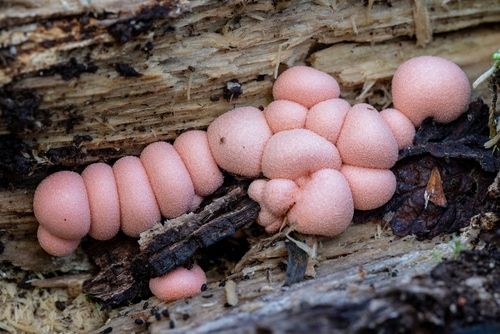
“Wolf Milk Slime Mold”.
©John Navajo/Shutterstock.com
The proceeding pink mushroom is Lycogala epidendrum, the “Wolf Milk Slime Mold”. This is quite common on dead logs, resembles tiny blobs of Pepto Bismol, and has a slimy interior. Furthermore, these tiny, gooey, toothpaste-textured balls of congealed slime lack both scents, as well as a taste of intrigue. In other words, don’t even bother trying to eat this bizarre growth.
10. Harrya chromapes
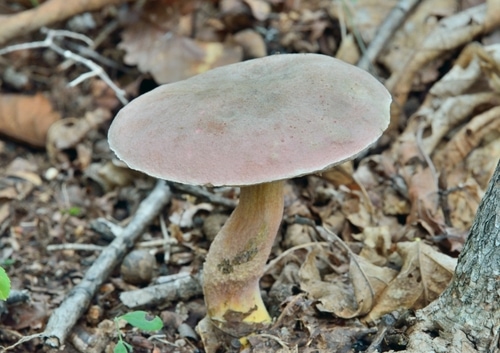
The “Yellowfoot Bolete” has a yellow base.
©Kirsanov Valeriy Vladimirovich/Shutterstock.com
Last but not least, Harrya chromapes, or the “yellow foot bolete”, is a beautiful member of the family Boletaceae. Considered a decent edible, it has a pink cap (more so when young), and the pores will age to pale pink as the spores mature.
The information presented on or through the Website is made available solely for general informational purposes. We do not warrant the accuracy, completeness, or usefulness of this information. Any reliance you place on such information is strictly at your own risk. We disclaim all liability and responsibility arising from any reliance placed on such materials by you or any other visitor to the Website, or by anyone who may be informed of any of its contents. None of the statements or claims on the Website should be taken as medical advice, health advice, or as confirmation that a plant, fungus, or other item is safe for consumption or will provide any health benefits. Anyone considering the health benefits of particular plant, fungus, or other item should first consult with a doctor or other medical professional. The statements made within this Website have not been evaluated by the Food and Drug Administration. These statements are not intended to diagnose, treat, cure or prevent any disease.
Thank you for reading! Have some feedback for us? Contact the AZ Animals editorial team.

